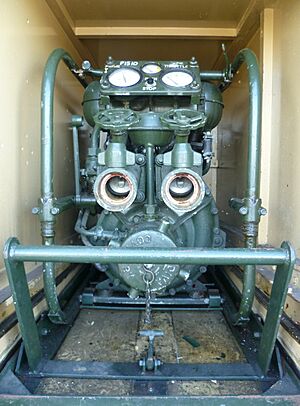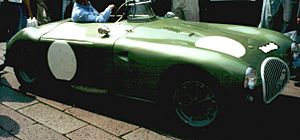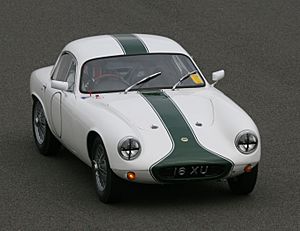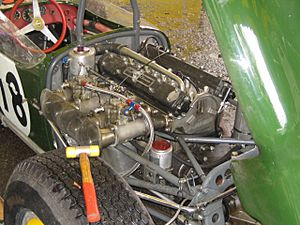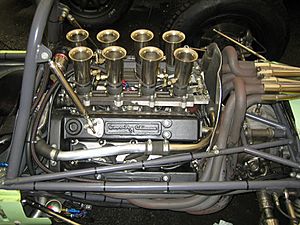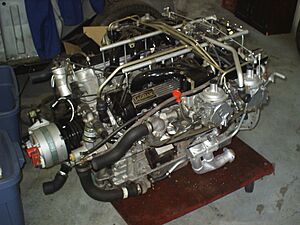Coventry Climax facts for kids
 |
|
| Limited company | |
| Industry | Speciality machinery and engine manufacture |
| Fate | Purchased by Jaguar Cars, businesses merged by British Leyland or divested |
| Predecessor | Johnson & Smith Ltd. |
| Successor | Kalmar Climax (forklift business) |
| Founded | 1903 |
| Defunct | 1986 (Coventry Climax Holdings Ltd) |
| Headquarters | Coventry |
|
Key people
|
|
| Formula One World Championship career | |
|---|---|
| First entry | 1957 Monaco Grand Prix |
| Last entry | 1969 Canadian Grand Prix |
| Races entered | 97 (96 starts) |
| Chassis | Cooper, Lotus, Fry, BRM, JBW, Ferguson, Gilby, Emeryson, Lola, Brabham, Scirocco, LDS, Eagle, Shannon |
| Constructors' Championships | 4 (1959, 1960, 1963, 1965) |
| Drivers' Championships |
4 (1959, 1960, 1963, 1965) |
| Race victories | 40 |
| Podiums | 104 |
| Points | 684 |
| Pole positions | 44 |
| Fastest laps | 44 |
Coventry Climax was a British company that made special engines. They were famous for building forklift trucks, fire pumps, and powerful engines for Formula One racing cars.
Contents
A Look at Coventry Climax History
Early Days and First Engines
The company started in 1903 as Lee Stroyer. In 1905, it moved to Coventry and was renamed Coventry Simplex. Horace Pelham Lee, who used to work for Daimler, saw a chance to make engines for the new cars being built.
Coventry-Simplex engines were used in many early cars. For example, the first Aston Martin car in 1913 used one. Even Ernest Shackleton chose their engines for tractors on his trip to Antarctica in 1914. During the First World War, hundreds of these engines helped power searchlights.
Growing After the Wars
In 1919, Pelham Lee bought another company and renamed it Coventry Climax Engines Ltd. They kept making engines for many car brands throughout the 1920s and 1930s. Some famous names included Morgan and Triumph.
When the economy was tough in the 1930s, Coventry Climax found new ways to use their engines. They started making engine-driven pumps. These pumps became very successful as mobile fire fighting machines, especially during the late 1930s and Second World War. They also made engines for buses and trucks.
After the Second World War, the company changed focus. They moved away from car engines to make more fire pumps and forklift trucks. In 1946, they launched the ET199 forklift, which they said was the first British-made forklift.
The Racing Engine Era
In 1950, a talented engineer named Harry Mundy joined Coventry Climax. He helped design a new, very light engine called the FW (Feather Weight). It was for a portable fire pump that needed to be powerful but also easy to carry.
This FW engine was so light and powerful that racing teams noticed it. People like Colin Chapman, who founded Lotus, thought it would be great for race cars. So, the team made a version for cars, called the FWA.
The first Coventry Climax racing engine appeared in 1954 at the 24 Hours of Le Mans race. The FWA engine became popular in sports car racing. Later, they made the FWB, which was nearly 1.5 liters. This engine was perfect for the new Formula Two rules.
By 1957, Coventry Climax engines were used in Formula One cars, especially in Cooper chassis. In 1958, Stirling Moss won the company's first Formula One race. In 1959, Jack Brabham won the world championship with a Cooper-Climax car.
In 1961, Formula One rules changed to 1.5-liter engines. Coventry Climax then developed a V8 engine called the FWMV. This engine became very successful, especially in Lotus cars driven by Jim Clark. They won 22 Grand Prix races before 1966.
Coventry Climax also helped make engines for regular cars. In the early 1960s, they worked with Rootes to mass-produce engines for a small family car. This car became the Hillman Imp, and over 400,000 units were made.
The Final Years
In 1962, the chairman, Leonard Pelham Lee, said Coventry Climax would stop making Formula One engines. He felt the company was losing money and not getting enough advertising from racing. Even so, they stayed in Formula One for a few more years.
In 1963, Jaguar Cars bought Coventry Climax. Later, Jaguar merged with other companies to form British Leyland. Coventry Climax became part of this larger group.
In the early 1970s, the fire pump business was sold and became Godiva Fire Pumps. In 1977, Coventry Climax bought another forklift company, renaming it Climax Conveyancer.
In 1982, the forklift business was sold again to a private company. However, in 1986, Coventry Climax went out of business. Its forklift parts were bought by Kalmar Industries, which now trades as Kalmar Industries Ltd.
How Coventry Climax Engines Were Designed
Two main engineers, Walter Hassan and Harry Mundy, were key to Coventry Climax's engine designs. They worked together on the famous FW engine.
Here are some cool things about their engine designs:
- Quick Start: The FW engine was designed for fire pumps. This meant it had to run at full power almost instantly, without needing a long warm-up. This made them very tough and durable for racing too.
- Smart Airflow: They designed the engines so that air and exhaust gases would swirl in a special way inside the engine. This helped the engine work better.
- V8 Engines: For their V8 racing engines (FWMV), they proved that a "flat-plane crankshaft" design was better for racing. This was a new idea at the time, and now many V8 racing engines use this design.
Types of Engines Made by Coventry Climax
F Type Engines
In 1923, Coventry Climax showed four F-type engines. These were 4-cylinder engines with different sizes, from 1.1 liters to 1.5 liters. They were used in cars like the GWK.
OC and MC Engines
The OC engine was a 1.1-liter, 4-cylinder engine introduced in the early 1930s. It was also built by Triumph. The MC engine was a slightly different version of the OC. These engines were cooled by water without a pump, like a natural flow system.
JM Engines
The JM engine was a 6-cylinder version of the MC engine. It came in sizes like 1.5 liters and 1.7 liters. Unlike the 4-cylinder engines, the JM had a water pump and an oil filter.
FW (Feather Weight) Engines
The FW engine was a 1.0-liter, 4-cylinder engine designed to be very light. It weighed only about 180 pounds! This engine was first made for portable fire pumps.
In 1953, it was changed for racing cars and called the FWA. It was 1.1 liters and made 71 horsepower. It was first used in a Kieft car at Le Mans in 1954.
The FWB was a larger 1.5-liter version. The FWE was a special 1.2-liter engine made for the Lotus Elite car. This engine was very popular in sports car racing because it was light and powerful. Lotus Elites with FWE engines won their class six times at the 24 Hours of Le Mans race.
FPE (Godiva) Engine
This was a 2.5-liter V8 engine built in 1954 for Formula One racing. It was called the "Godiva." It was very powerful, making 264 horsepower. However, it was not used much in races because the company decided to focus on other engines.
FPF Engines
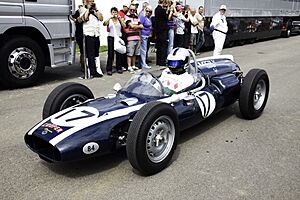
The FPF was a 4-cylinder racing engine made from 1955. It was very successful. It started as a 1.5-liter engine for Formula Two races.
Later, it was made bigger for Formula One. A 2.0-liter version helped Stirling Moss win races in 1958. Then, a 2.5-liter FPF engine helped Jack Brabham win the World Championship in 1959 and 1960. This engine was also used in the Indianapolis 500 race.
FWMV Engines
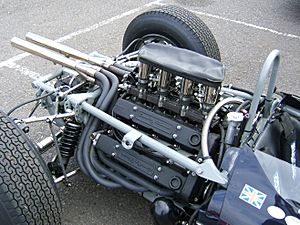
The FWMV was a 1.5-liter V8 engine designed in 1960. It was very powerful for its size, making over 180 horsepower. It debuted in 1961 and quickly started winning races.
In 1963, a new version of the FWMV helped Jim Clark and Team Lotus win 7 races and the World Championship. Later versions made even more power. Overall, FWMV engines helped Cooper, Lotus, and Brabham Formula One cars win 22 Grand Prix races.
Jaguar V12 Engine Connection
When Jaguar bought Coventry Climax in 1963, the engineers there helped design the famous Jaguar V12 engine. This engine was first made for racing in 1966. Later, it was used in Jaguar cars like the Jaguar E-Type starting in 1971 and stayed in production until 1997.
Coventry Climax in Formula One Racing
From 1958 to 1965, cars with Coventry Climax engines won 40 Formula One World Championship Grand Prix races. They also won many other non-championship races.
The last time a Coventry Climax engine won an international race was in 1966. The last time a car with a Coventry Climax engine entered a World Championship Grand Prix was in 1969.
Formula One Wins
| Year | Race | Entrant | Driver | Chassis | Engine |
|---|---|---|---|---|---|
| 1958 | Argentine Grand Prix | R.R.C. Walker Racing Team | Cooper T43 | FPF | |
| Monaco Grand Prix | Cooper T45 | ||||
| 1959 | Monaco Grand Prix | Cooper Car Company | Cooper T51 | FPF | |
| British Grand Prix | |||||
| Portuguese Grand Prix | R.R.C. Walker Racing Team | ||||
| Italian Grand Prix | |||||
| United States Grand Prix | Cooper Car Company | ||||
| 1960 | Argentine Grand Prix | Cooper Car Company | Cooper T51 | FPF | |
| Monaco Grand Prix | R.R.C. Walker Racing Team | Lotus 18 | |||
| Dutch Grand Prix | Cooper Car Company | Cooper T53 | |||
| Belgian Grand Prix | |||||
| French Grand Prix | |||||
| British Grand Prix | |||||
| Portuguese Grand Prix | |||||
| United States Grand Prix | R.R.C. Walker Racing Team | Lotus 18 | |||
| 1961 | Monaco Grand Prix | R.R.C. Walker Racing Team | Lotus 18 | FPF Mk II | |
| German Grand Prix | Lotus 18/21 | ||||
| United States Grand Prix | Team Lotus | Lotus 21 | |||
| 1962 | Monaco Grand Prix | Cooper Car Company | Cooper T60 | FWMV | |
| Belgian Grand Prix | Team Lotus | Lotus 25 | |||
| British Grand Prix | |||||
| United States Grand Prix | |||||
| 1963 | Belgian Grand Prix | Team Lotus | Lotus 25 | FWMV | |
| Dutch Grand Prix | |||||
| French Grand Prix | |||||
| British Grand Prix | |||||
| Italian Grand Prix | |||||
| Mexican Grand Prix | |||||
| South African Grand Prix | |||||
| 1964 | Dutch Grand Prix | Team Lotus | Lotus 25 | FWMV | |
| Belgian Grand Prix | |||||
| French Grand Prix | Brabham Racing Organisation | Brabham BT7 | |||
| British Grand Prix | Team Lotus | Lotus 25 | |||
| Mexican Grand Prix | Brabham Racing Organisation | Brabham BT7 | |||
| 1965 | South African Grand Prix | Team Lotus | Lotus 33 | FWMV | |
| Belgian Grand Prix | |||||
| French Grand Prix | Lotus 25 | ||||
| British Grand Prix | Lotus 33 | ||||
| Dutch Grand Prix | |||||
| German Grand Prix |
Cars Powered by Coventry Climax Engines
Here are some famous cars that used Coventry Climax engines:
- 1911 GWK (Coventry Simplex engine)
- 1913 Bamford & Martin (the first Aston Martin)
- 1922 Clyno
- 1930 Crossley 10
- 1936 Morgan 4-4
- 1954 Kieft-Climax 1100 LeMans
- 1955 Cooper T39 Climax 'Bobtail'
- 1955 Lotus Mark IX
- 1956–7 Lotus Eleven
- 1957 Cooper T43 Climax (first mid-engine car to win a Grand Prix)
- 1957-63 Lotus Elite
- 1958 TVR Grantura
- 1959 Cooper T51 (World Champion car)
- 1960 Lotus 18
- 1960 Cooper T53 (World Champion car)
- 1961 Cooper T54 (first mid-engine Indy car)
- 1962-65 Lotus 25 (World Champion car)
- 1963–76 Hillman Imp (engine design inspired by Coventry Climax)
- 1965 Lotus 33 (World Champion car)


